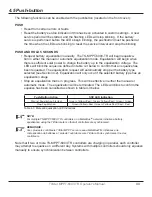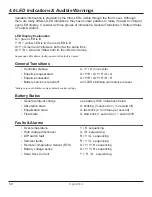
42
Operation
Float Stage
After the battery is fully charged in the Absorption stage, the TS-MPPT-600V-TR reduces the
battery voltage to the Float voltage set-point. When the battery is fully recharged, there can be
no more chemical reactions and all the charging current is turned into heat and gassing. The float
stage provides a very low rate of maintenance charging while reducing the heating and gassing
of a fully charged battery. The purpose of float is to protect the battery from long-term over
-
charge. The green SOC LED will blink once every two (2) seconds during Float charging.
Once in Float stage, loads can continue to draw power from the battery. In the event that the
system load(s) exceed the solar charge current, the controller will no longer be able to maintain
the battery at the Float set-point. Should the battery voltage remain below the Float set-point for
a cumulative 60 minute period, the controller will exit Float stage and return to Bulk charging.
The Float set-point is temperature compensated if the RTS is connected.
Equalize Stage
WARNING: Risk of Explosion
Equalizing vented batteries produces explosive gases. The battery bank must be properly
ventilated.
!
CAUTION: Equipment Damage
Equalization increases the battery voltage to levels that may damage sensitive DC loads. Verify
all system loads are rated for the temperature compensated Equalize voltage before beginning
an Equalization charge.
!
CAUTION: Equipment Damage
Excessive overcharging and gassing too vigorously can damage the battery plates and cause
shedding of active material from the plates. An equalization that is too high or for too long can
be damaging. Review the requirements for the particular battery being used in your system.
AVERTISSEMENT : Risque d’explosion
Les batteries à évent et compensation produisent des gaz explosifs. Le groupe de batteries doit
être correctement ventilé.
!
PRUDENCE : Endommagement de l’équipement
La compensation augmente la tension des batteries à des niveaux pouvant endommager les
charges sensibles en CC. Vérifiez que toutes les charges du système sont conçues pour la
tension de compensation par température avant de commencer une charge de compensation.
!
PRUDENCE : Endommagement de l’équipement
Une surcharge excessive et un dégagement gazeux trop vigoureux peuvent endommager les
plaques de batteries et provoquer l’élimination du matériau actif des plaques. Une compensation
trop élevée ou trop longue peut provoquer des dégâts. Examinez les exigences pour la batterie
particulière utilisée dans votre système.






























